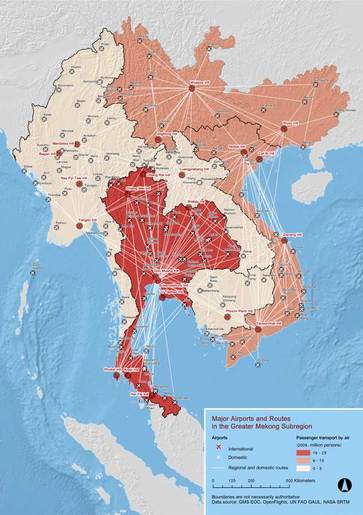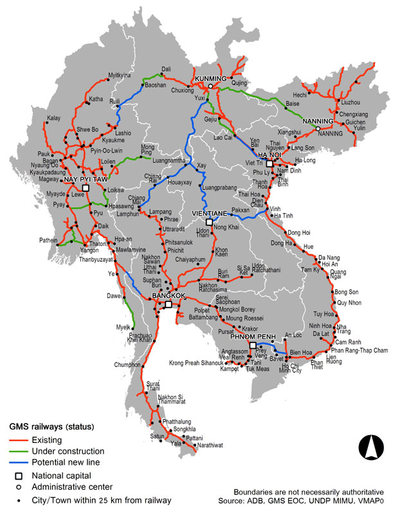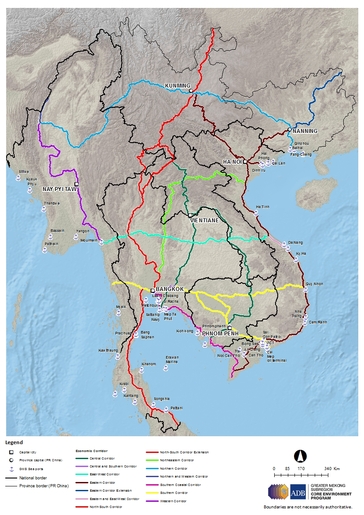-
August 31, 2017ADB
Trade Facilitation and Better Connectivity for an Inclusive Asia and Pacific
-
May 31, 2017ADB
Lessons from ADB Transport Projects: Moving Goods, Connecting People, and Disseminating Knowledge
-
March 31, 2017OECD
Climate-Resilient Infrastructure: Getting the Policies Right
-
December 31, 2016FAO
Guide for planning, construction and maintenance of forest roads
-
October 31, 2016Mekong Institute
Study On Market & Value Chain Mapping in the Southern Economic Corridor and Southern Coastal Corridor of the Greater Mekong Subregion
-
September 12, 2016ASEAN
Master Plan on ASEAN Connectivity 2025
-
August 01, 2016Asian Development Bank
Video: New Road in Lao PDR Changes Everything
-
August 01, 2016Asian Development Bank
Greater Mekong Subregion Statistics on Growth, Infrastructure and Trade (Second Edition)
-
May 31, 2016UNEP, Global Infrastructure Basel (GIB)
Sustainable Infrastructure and Finance
-
May 16, 2016Mekong Institute
Development Potential for International Shipping on the Lancang-Mekong River (China, Lao PDR, Myanmar and Thailand)
-
September 09, 2015ADB
Greater Mekong Subregion Statistics On Growth, Connectivity and Sustainable Development (First Edition)
-
July 14, 2015Grantham Research Institute on Climate Change and the Environment
Driving Sustainable Development Through Better Infrastructure: Key Elements of A Transformation Program
-
April 14, 2015GMS Core Environment Program
Green Freight in the Greater Mekong Subregion
-
August 07, 2014
Green Freight and Logistics in Asia: Delivering the Goods, Protecting the Environment
-
25th March 2018
Source: Khmer TimesMekong-Japan cooperation in the Indo-Pacific strategy
-
16th March 2018
Source: Vietnam NetGreater Mekong Subregion countries to boost transportation connectivity
-
14th March 2018
Source: Bangkok PostGovt ready to scrap region border checks
-
14th March 2018
Source: The NationGovt to ease transport woes with neighbouring nations
-
12th March 2018
Source: Khmer TimesEngendering an inclusive Asean
-
12th March 2018
Source: Nhan DanWB to help Vietnam in public transport development, drainage planning
-
11th March 2018
Source: Vientiane TimesLuang Prabang hopes improved road links will lure more tourists
-
7th March 2018
Source: Khmer TimesCambodia eyes water transport body
-
7th March 2018
Source: VN ExpressHCMC secures $5 billion from Canadian fund for Mekong Delta rail link
-
6th March 2018
Source: Vietnam PlusTransport – a highlight of GMS Economic Cooperation Programme
-
27th February 2018
Source: XinhuaThailand sets up technological center for Belt and Road Initiative
-
3rd February 2018
Source: National News Bureau of ThailandThailand - Wildlife corridor will boost ecology and economy, says Transport Minister
-
2nd February 2018
Source: The NationLaos-China Belt and Road Cooperation Forum kicks off
-
1st February 2018
Source: Lao News AgencyBelt and Road Forum for Laos-China Cooperation Opens
-
11th January 2018
Source: Khmer TimesCambodia - Key agreements signed with China on expressway, airport
-
10th January 2018
Source: Bangkok PostThailand - Riverside nations adopt Mekong action plan
-
10th January 2018
Source: Lao News AgencyLao PDR - Laos to Co-host MLC Meeting
-
8th January 2018
Source: Lao News AgencyLaos-China Hi-Speed Railway Construction Progresses 16%
-
4th January 2018
Source: Bangkok PostThailand - Prayut set for vital Mekong region summit
-
4th January 2018
Source: Khmer TimesCambodia - GMS to enhance cooperation
-
2nd January 2018
Source: Vientiane TimesLao PDR - China injects 29b kip for Mekong-Lancang projects
-
28th December 2017
Source: Khmer TimesCambodia - $20 million deal inked to fix roads
-
19th December 2017
Source: The NationChina ‘ready to amend’ Mekong plan
-
10th December 2017
Source: Vientiane TimesLao PDR - River transport, signage among tourism improvements mooted
-
3rd December 2017
Source: Khmer TimesCambodia - New Malaysia route takes off
-
26th November 2017
Source: Vientiane TimesLao PDR - More tourists making their way to Laos by road
-
24th November 2017
Source: The Nation‘One Belt, One Road’ initiative underway, but experts warn of difficulties ahead
-
21st November 2017
Source: Mekong EyeChina moots economic corridor with Myanmar for easy access to Indian Ocean
-
19th November 2017
Source: Khmer TimesCambodia - Trains collide in Kampot province
-
5th November 2017
Source: XinhuaNetLao PM visits construction site of China-Laos railway
-
1st November 2017
Source: ADBADB to Support Development of Green, Resilient Urban Infrastructure in Viet Nam's Secondary Cities
-
24th October 2017
Source: MizzimaMyanmar to reap greater rewards in deep-sea port development project
-
19th October 2017
Source: Khmer TimesCambodia - Skytrain studies completed
-
14th October 2017
Source: Asian TribuneChina’s Myanmar bonanza sans responsibility
-
28th September 2017
Source: Ministry of Environmental ProtectionChian - Guizhou plans ambitious electric vehicle charging network by 2020
-
27th September 2017
Source: Bangkok PostThailand - Mekong clearance will destroy 'a few islets'
-
25th September 2017
Source: Khmer Times$64b GMS action plan
-
21st September 2017
Source: Myanmar TimesASEAN countries “keen” and “ready” for Belt and Road: HKTDC
-
20th September 2017
Source: Viet Nam NewsGMS ministerial meeting plans for future
-
14th September 2017
Source: Khmer TimesCambodia-Thai-Vietnam bus service
-
27th August 2017
Source: The Myanmar TimesMyanmar - State Counsellor stresses Belt and Road needs to align national priorities
-
27th August 2017
Source: Bangkok PostThailand - Department to open bids for airport upgrades
-
21st August 2017
Source: CNNLao PDR - Could new China railway put Laos on the tourist map?
-
20th August 2017
Source: Vientiane TimesLao PDR - Vientiane continuing consultation on road fund
-
16th August 2017
Source: Vientiane TimesLao PDR - Govt urges local jobs on Laos-China railway project
-
16th August 2017
Source: Vientiane TimesLao PDR - Road collapse causes major inconvenience in Phongsaly
-
16th August 2017
Source: Vientiane TimesLaos-Thailand railway to launch freight transport service in few months
-
13th August 2017
Source: Khmer TimesCambodia - Airport railway project halted
-
9th August 2017
Source: The Phnom Penh PostCambodia - AirAsia launches flight from Kuala Lumpur to Sihanoukville
-
7th August 2017
Source: Khmer TimesCambodia - PM asks Japan to invest $800m in skytrain
-
2nd August 2017
Source: Myanmar TimesMyanmar’s stakes in two Belt and Road economic corridors
-
1st August 2017
Source: Khmer TimesCambodia - New rail link boosts Phnom Penh property developer confidence
-
23rd July 2017
Source: Khmer TimesCambodia - Airport railway revealed as residents worry
-
14th July 2017
Source: MizzimaThe construction of BCIM Economic Corridor vs. Myanmar
-
12th July 2017
Source: Myanmar TimesMyanmar - Lack of accountability and clarity in SEZ Law highlighted in Dawei
-
4th July 2017
Source: Vientiane TimesLao PDR - Nasak-Khokkhaodor Bridge to officially open this month
-
1st July 2017
Source: VN ExpressViet Nam - Ho Chi Minh City plans $3.6 billion rail connection with Mekong Delta
-
25th June 2017
Source: Bangkok PostThailand - East-west coastal railway link mulled
-
23rd June 2017
Source: Bangkok PostThailand - New railway to connect marine life to sea
-
18th June 2017
Source: VN ExpressVietnam’s legislators approve to fast-track multi-billion-dollar airport
-
12th June 2017
Source: Vientiane TimesLao PDR - Attapeu tourism development requires more all-season roads
-
7th June 2017
Source: Myanmar TimesMyanmar - Car rallies expected to rev up tourism with Thailand
-
7th June 2017
Source: Khmer TimesCambodia - Mango exporter unfazed by Qatar crisis
-
5th June 2017
Source: Myanmar TimesChina-Myanmar Border Economic Cooperation Zone location speculated
-
4th June 2017
Source: Myanmar TimesMyanmar - Investor-friendly environment and human capital essential for Myanmar’s success in the Belt and Road Initiative
-
1st June 2017
Source: Ministry of Environmental ProtectionChina to advance green, low-carbon transportation development: Minister
-
31st May 2017
Source: Vientiane TimesLao PDR - Six bidders considered for Vientiane-Pakxe expressway development
-
30th May 2017
Source: Eco-BusinessUsing high-tech infrastructure to fight climate change
-
30th May 2017
Source: Myanmar TimesThe high road to warmer Myanmar-China ties
-
29th May 2017
Source: Myanmar TimesMyanmar - Transport experts encourage Myanmar to adopt PPP model
-
28th May 2017
Source: Vientiane TimesLao PDR - Works underway for Vientiane-Vangvieng expressway
-
28th May 2017
Source: Vientiane TimesLaos-China railway operational in 2021, 51 tunnel entrances bored
-
28th May 2017
Source: ADBADB-Blog: Using high-tech infrastructure to fight climate change
-
26th May 2017
Source: Mekong EyePaying for progress: Getting the private sector to pull its weight
-
24th May 2017
Source: Vientiane TimesLao PDR - Govt takes step to develop VungAng Seaport
-
24th May 2017
Source: The NationThailand - Bangkok roads flooded following heavy overnight rains
-
24th May 2017
Source: Bangkok PostThai-Sino high-speed rail work could start by August
-
23rd May 2017
Source: Khmer TimesCambodia - Cross-border highways vital for bilateral trade
-
22nd May 2017
Source: Khmer TimesAirline tax to help clean up Cambodia
-
21st May 2017
Source: Myanmar TimesMyanmar - Two countries one destination with Cambodia planned
-
20th May 2017
Source: Mekong EyeChina’s ‘Belt and Road’ Policy Benefits Cambodia, Analysts Say
-
18th May 2017
Source: Bangkok PostWith river sacrifice, regime yields to Beijing
-
17th May 2017
Source: Khmer TimesCambodia - New airline plans Thai flights
-
17th May 2017
Source: Vientiane TimesLao PDR - Plans gather steam for railway linking Vientiane to Vietnamese seaport
-
17th May 2017
Source: Vientiane TimesLao PDR - Vientiane expressway route under scrutiny
-
17th May 2017
Source: The ConservationWhat’s at stake in China’s plan to blow up islands in the Mekong
-
16th May 2017
Source: Khmer TimesCambodia - National rail system in the pipeline
-
16th May 2017
Source: Vientiane TimesLaos-China railway construction ‘progressing well’
-
16th May 2017
Source: Vientiane TimesLao PDR - Vehicle owners to pay higher road tax in August
-
16th May 2017
Source: Ministry of Environmental Protection (MEP)China - Pollution from diesel vehicles worldwide underestimated by 50 percent: study
-
15th May 2017
Source: Ministry of Environmental ProtectionChina - List of Deliverables of the Belt and Road Forum for International Cooperation
-
14th May 2017
Source: Agence Kampuchea PresseCambodia Is One of the Main Supporters of the Belt and Road Initiative
-
14th May 2017
Source: Ministry of Environmental ProtectionChina - Four ministries jointly issued the Guidance on Promoting Green Belt and Road
-
14th May 2017
Source: Ministry of Environmental ProtectionUNEP to boost a green Belt and Road Initiative
-
11th May 2017
Source: Ministry of Environmental Protection (MEP)China - Scientists set sustainable development goals for Belt and Road
-
10th May 2017
Source: The Phnom Penh PostCambodia - AirAsia to start flights to Sihanoukville
-
10th May 2017
Source: Myanmar TimesMyanmar - No airport extension in Ngapali until trash is slashed
-
10th May 2017
Source: MizzimaChina, Myanmar must cooperate to overcome challenges on Belt and Road
-
10th May 2017
Source: Vientiane TimesLao PDR - President to attend Road and Belt Forum in China
-
10th May 2017
Source: Agence Kampuchea PresseAIIB President Re-affirms Commitment for ASEAN’s Infrastructure Development
-
10th May 2017
Source: Ministry of Environmental ProtectionChina prioritizes a ‘Green Belt and Road’
-
9th May 2017
Source: The NationThailand - Outrage over Mekong EIA process
-
8th May 2017
Source: VN ExpressViet Nam - 'High quality' train service now connects Hanoi and Sa Pa
-
7th May 2017
Source: ADBAfter 50 years, Asian Development Bank looks ahead
-
7th May 2017
Source: Khmer TimesCambodia - Kampot seaport construction to start
-
7th May 2017
Source: ADBADB-Article: Infrastructure Development in Asia: 12 Things to Know
-
6th May 2017
Source: VietNamNet BridgeChina’s blasting of Mekong will cause environmental peril
-
4th May 2017
Source: The Myanmar TimesMyanmar - Water taxi scheme details to be announced next week
-
3rd May 2017
Source: VN ExpressChina's Silk Road threatens the mighty Mekong River
-
1st May 2017
Source: Khmer TimesCambodia-China cooperation
-
1st May 2017
Source: Vientiane TimesLaos-China railway will rev up pace of development
-
1st May 2017
Source: The NationThailand - First Chinese tour group to enter Kingdom via Mekong River
-
25th April 2017
Source: MizzimaMyanmar - Transportation and electricity sectors most important infrastructural challenges – Suu Kyi
-
25th April 2017
Source: Vientiane TimesLao PDR - Cross-border bridge congestion target of Savan Park proposal
-
24th April 2017
Source: The NationThailand - Governor denies bid to stop protest on Mekong blasting
-
24th April 2017
Source: Khmer TimesCambodia - Bridge strengthens bilateral trade ties
-
24th April 2017
Source: Khmer TimesCambodia - Railway firm eyes Cambodia
-
21st April 2017
Source: The AustralianLao and now: Mekong River, Vientiane, Thailand
-
17th April 2017
Source: The NationThailand - Survey work to begin on Mekong River channel improvement
-
3rd April 2017
Source: Vietiane TimesLaos-China direct flight serves to promote cooperation
-
30th March 2017
Source: Khmer TimesCambodia - Airports raise a smile
-
29th March 2017
Source: Vientiane TimesLao PDR - Rail freight set to cut transport costs significantly
-
28th March 2017
Source: The Cambodia DialyCambodia - Protesters Seek Answers on Planned Railway Road
-
26th March 2017
Source: Bangkok PostThailand - New setback looms for Thai-Sino rail project
-
26th March 2017
Source: Vientiane TimesLao PDR - Tunnel boring must start before rain, authorities
-
23rd March 2017
Source: Vientiane TimesLao-Thai railway section I ready for service
-
23rd March 2017
Source: Vientiane TimesLao PDR - Lao, Japanese experts discuss city bus transport system
-
21st March 2017
Source: Khmer TimesCambodia-Laos air? links increased
-
20th March 2017
Source: Vientiane TimesLao PDR - Tunnel boring for Laos-China railway expected in coming weeks
-
20th March 2017
Source: Lao News AgencyLao PDR - Vietnam's Vung Ang Port vital for shipment of Lao goods
-
20th March 2017
Source: ADBADB-Article: What Does Climate Change Mean for Asia’s Future Infrastructure?
-
19th March 2017
Source: Khmer TimesNew airline launches in Cambodia
-
16th March 2017
Source: Lao News AgencyAsian Countries Committed to Development of Sustainable Rural Transport
-
15th March 2017
Source: Khmer TimesThailand rail link held up by compensation claims
-
15th March 2017
Source: The NationThailand - Tense standoff between protesters and police over Pak Bara deep-sea port
-
13th March 2017
Source: Lao News AgencyLao PDR - Gov’t Plans to Promote Transport Infrastructure
-
9th March 2017
Source: Lao News AgencyASEAN Pushes for Air Transport Service
-
7th March 2017
Source: The Cambodia DialyCambodia - All Tonle Sap Fishing Boats to Be Registered, Minister Says
-
7th March 2017
Source: Channel News AsiaThailand - Thai conservationists oppose plan to dredge Mekong River
-
1st March 2017
Source: Lao News AgencyLao Skyway Launches New Flight
-
27th February 2017
Source: ADBADB-Article: What Infrastructure Does Asia Need, and Why?
-
27th February 2017
Source: ADBADB-Article: How Much Should Asia Spend on Infrastructure?
-
10th February 2017
Source: VietNamNet BridgeViet Nam - Air pollution from vehicles top concern of city authorities
-
31st January 2017
Source: ADBADB-Op-eds: Connecting Asia's growth poles
-
30th January 2017
Source: The Myanmar TimesMyanmar - Yangon govt ups transport spending for new buses
-
24th January 2017
Source: MRCMekong River clearance plan raises fears
-
23rd January 2017
Source: Khmer TimesAirAsia to open Cambodia office
-
23rd January 2017
Source: The Myanmar TimesMyanmar - Kawthaung airport upgrade to bring international tourists
-
21st January 2017
Source: ElevenGermany looks to boost green Mekong transport
-
18th January 2017
Source: The Phnom Penh PostCambodia joins global infrastructure fund in Davos
-
17th January 2017
Source: Bangkok PostThailand - Exat schedules Phuket, Bangkok expressways
-
17th January 2017
Source: Bangkok PostThailand-Cambodia rail link delayed again
-
15th January 2017
Source: Ministry of Environmental Protection (MEP)China - Beijing to spend billions to tackle air pollution in 2017
-
12th January 2017
Source: Khmer TimesCambodia - Expressway to Vietnam on cards
-
8th January 2017
Source: Bangkok PostThailand - Locals slam Mekong blasting plan
-
8th January 2017
Source: ADBADB News - ADB Operations Reach a Record $31.5 Billion in 2016
-
5th January 2017
Source: Khmer TimesCambodia - Kampot seaport to boost tourism
-
5th January 2017
Source: Ministry of Environmental Protection (MEP)China - Tianjin: 500 electric buses hit roads in China's latest clean energy push
-
3rd January 2017
Source: Ministry of Environmental ProtectionChina to track second-hand vehicle emissions
-
3rd January 2017
Source: Ministry of Environmental ProtectionHeavy fog, smog continue to disrupt traffic in China
-
2nd January 2017
Source: Vientiane TimesLao PDR - Kasy town to be relocated to make way for railway
-
29th December 2016
Source: Lao News AgencyLao PDR - Luang Prabang Confirms Sufficient Electricity to Supply Laos-China Railway
-
28th December 2016
Source: The NationThailand - Phetchabun national park road proposal put on hold
-
26th December 2016
Source: The IrrawaddyMyanmar - Plans Announced for SEZ and New Airport Terminal in Southern Rangoon
-
20th December 2016
Source: ADBADB to Support Ho Chi Minh City's Third Ring Road Development by PPP
-
20th December 2016
Source: ADBADB News - Strong Environmental and Social Safeguards Must Accompany Asia’s Infrastructure Drive
-
1st December 2016
Source: ADBADB: Expanded Road Networks to Link Mekong Capitals, Boost Investment
-
28th November 2016
Source: WWFTigers at a Crossroads in the Greater Mekong due to roads, dams
-
14th October 2016
Source: Agence Kampuchea Presse (AKP)Cambodia - Minister of Public Work and Transport Signs Agreements on 4 Infrastructure Projects with Chinese Companies
-
13th October 2016
Source: Mekong EyeMyanmar government and civil society hold landmark consultations on public participation in infrastructure development
-
5th October 2016
Source: The Phnom Penh PostADB to muscle up its lending with pledge of $1B
-
2nd October 2016
Source: The CambodiadailyXi to Make First Presidential Visit This Month
-
6th September 2016
Source: China DailyJoint Statement of the 19th ASEAN-China Summit to Commemorate the 25th Anniversary of ASEAN-China Dialogue Relations
-
14th August 2016
Source: MRCNew funding from Belgium will boost navigation and cross-border trade
-
8th August 2016
Source: Agence Kampuchea Press (AKP)Cambodia Hosts 8th GMS Economic Corridors Forum
-
4th August 2016
Source: China dailyHighway corridor links Chongqing to SE Asia
-
27th July 2016
Source: DCC/GSSD CambodiaCambodia - Two sectoral ministries improved and strengthened climate responsive budget and planning for 2017




